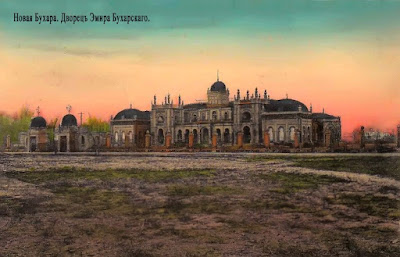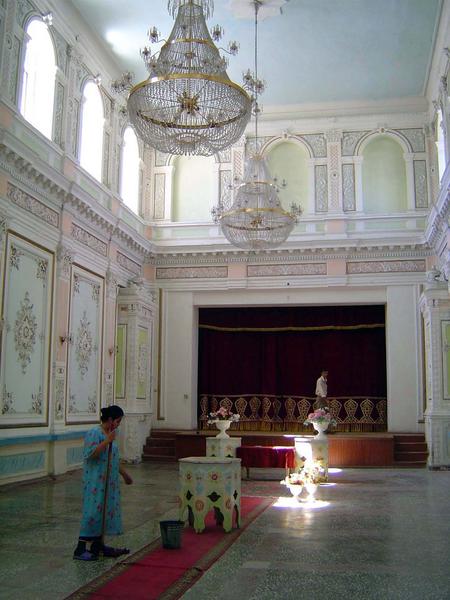 |
| 19th century postcard of Kagan Palace, designed by Alexey Leontievich Benoit |
For a vast sum of silver, the Emir consented, on condition that the railway line did not come within 16 kms of the city of Bukhara.
So the Russians built a new settlement outside, in nearby Kagan. The railway line opened in 1888. This area became the "new town", where Russians settled. And to this day, there are large numbers of Russian who live in Kagan.
The Emir of Bukhara had visited St Petersburg for the coronations of Alexander III and Nicholas II; he was taken with the flamboyant architectural style of the city. It is said that Tsar Nicholas II had planned to visit Bukhara and the Emir wished to accommodate him and his retinue in luxury. He engaged the famous Russian architect, Alexey Leontievich Benoit, to build a palace at Kagan. Construction began in 1895.
 |
| Kagan Palace today |
The wedding cake palace in Kagan - an eclectic mix of Moorish, Empire and Baroque styles - still stands today. It features an extravagance of turrets, columns and domes. The internal decoration is a fusion of Oriental, Arabian and Empire motifs.
Unfortunately, historical events overtook Nicholas II, and he did not visit Turkestan. For some time the residence was a hotel for visiting dignitaries - non-Muslims not permitted to enter the holy city of Bukhara. Later it was used by the tsarist Russian political commissar.
In 1920, after the Soviet conquest of the Bukharan emirate, it became the social club for the railway proletariat. Today it belongs to the Kagan municipal authority and houses a small railway museum. The banquet hall is the venue for local cultural performances and can be hired for a soiree if you so desire.
 |
| The entrance hall today. Image: Bret Wallach |
Also tucked away in Kagan is the small Russian Orthodox church of St Nicholas dating from 1892. It has been extensively rebuilt and was reconsecrated in 1969.
Some historians refer to this building as the Versailles of Central Asia. Judge for yourself from the images below.
Related posts:
Travelling by Rail in Uzbekistan
Chor Bakyr - The City of the Dead, near Bukhara
Bukhara's Summer Palace: Sitora-i Mokhi-Khosa
Bukhara's Contemporary Art Museum
 |
| The Palace today. Image: Bret Wallach |
 |
| Close up of the external wall. Image: Bret Wallach |
 |
| The Emir's office - a riot of gorgeous Eastern patterns. Image: Bret Wallach |
 |
| The ballroom, with Soviet era floor. Image: Bret Wallach |
 |
| Emir Abdul Ahad of Bukhara, who commissioned the palace |